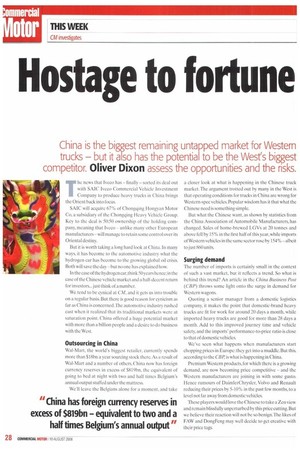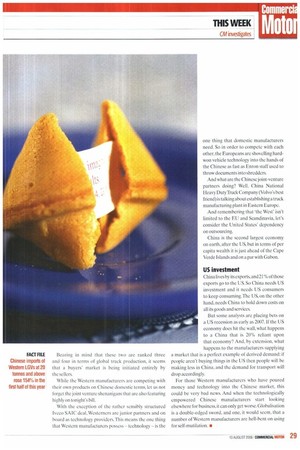Hostage to fortune
Page 28

Page 29

If you've noticed an error in this article please click here to report it so we can fix it.
China is the biggest remaining untapped market for Western trucKs — but it also has the potentia to be the Wesfs biggest
competitor. Oliver Dixon assess the opportunities and the risks.
The news that Iveco has finally sorted its deal out with SA1C Iveco Commercial Vehicle Investment Company to produce heavy trucks in China brings the Orient back into focus.
SAW will acquire 67% of Chongqing Hongyan Motor Co, a subsidiary of the Chongqing Heavy Vehicle Group. Key to the deal is 50:50 ownership of the holding company, meaning that Iveco unlike many other European manufacturers will manage to retain some control over its Oriental destiny.
But it is worth taking a long hard look at China. In many ways, it has become to the automotive industry what the hydrogen car has become to the growing global oil crisis. Both will save the day but no one has explained how.
In the case of the hydrogen car, think 50 years hence; in the case of the Chinese vehicle market and a half-decent return for investors... just think of a number.
We tend to be cynical at CM, and it gets us into trouble on a regular basis. But there is good reason for cynicism as far as China is concerned. The automotive industry rushed east when it realized that its traditional markets were at saturation point. China offered a huge potential market with more than a billion people and a desire to do business with the West.
Outsourcing in China
Wal-Mart, the world's biggest retailer, currently spends more than $18bn a year sourcing stock there. As a result of Wal-Mart and a number of others, China now has foreign currency reserves in excess of S819bn, the equivalent of going to bed at night with two and half times Belgium's annual output stuffed under the mattress.
We'll leave the Belgians alone for a moment, and take a closer look at what is happening in the Chinese truck market. The argument trotted out by many in the West is that operating conditions for trucks in China are wrong for Western-spec vehicles. Popular wisdom has it that what the Chinese need is something simple.
But what the Chinese want, as shown by statistics from the China Association of Automobile Manufacturers, has changed. Sales of home-brewed LGVs at 20 tonnes and above fell by 15% in the first half of this year, while imports ofWestern vehicles in the same sector rose by 154% albeit to just 860 units.
Surging demand The number of imports is certainly small in the context of such a vast market, but it reflects a trend. So what is behind this trend? An article in the China Business Post (CBP) throws some light onto the surge in demand for Western wagons.
Quoting a senior manager from a domestic logistics company, it makes the point that domestic-brand heavy trucks are fit for work for around 20 days a month, while imported heavy trucks are good for more than 28 days a month. Add to this improved journey time and vehicle safety, and the imports' performance-to-price ratio is close to that of domestic vehicles.
We've seen what happens when manufacturers start chopping prices in Europe: they get into a muddle. But this, according to the cBe is what is happening in China.
Premium Western products, for which there is a growing demand. are now becoming price competitive and the Western manufacturers are joining in with some gusto. Hence rumours of DairnlerChrysler, Volvo and Renault reducing their prices by 5-10% in the past few months, to a level not far away from domestic vehicles.
These players would love the Chinese to take a Zen view and remain blissfully unperturbed by this price cutting. But we believe their reaction will not be so benign. The likes of FAW and DongFeng may well decide to get creative with their price tags. Bearing in mind that these two are ranked three and four in terms of global truck production, it seems that a buyers market is being initiated entirely by the sellers.
While the Western manufacturers are competing with their own products on Chinese domestic terms, let us not forget the joint venture shenanigans that are also featuring highly on tonight's bill.
With the exception of the rather sensibly structured Iveco SAIC deal. Westerners are junior partners and on board as technology providers.This means the one thing that Western manufacturers possess — technology — is the one thing that domestic manufacturers need. So in order to compete with each other. the Europeans are shovelling hardwon vehicle technology into the hands of the Chinese as fast as Enron staff used to throw documents into shredders.
And what are the Chinese joint-venture partners doing? Well. China National Ifeavy Duty Truck Company (Volvo's best friend) is talking about establishing a truck manufacturing plant in Eastern Europe.
And remembering that 'the West' isn't limited to the EU and Scandinavia, let's consider the United States' dependency on outsourcing.
China is the second largest economy on earth, after the US, hut in terms of per capita wealth it is just ahead of the Cape Verde Islands and on a par with Gabon.
US investment
China lives by its exports, and 21% of those exports go to the US. So China needs US investment and it needs US consumers to keep consuming. The US, on the other hand, needs China to hold down costs on all its goods and services.
But some analysts are placing bets on a US recession as early as 2007.1f the US economy does hit the wall, what happens to a China that is 20% reliant upon that economy? And, by extension, what happens to the manufacturers supplying a market that is a perfect example of derived demand: if people aren't buying things in the US then people will be making less in China, and the demand for transport will drop accordingly.
For those Western manufacturers who have poured money and technology into the Chinese market, this could be very had news. And when the technologically empowered Chinese manufacturers start looking elsewhere for business, it can only get worse. Globaiisation is a double-edged sword, and one, it would seem, that a number of Western manufacturers are hell-bent on using for self-mutilation. •




























































































































































































